JharBhoomi
JharBhoomi is the official land records portal of Jharkhand launched in 2016.It’s a website specifically designed for the state to make land record management transparent and convenient for citizens.
This Jharbhoomi portal has eliminated the need for physical visits to government offices.
Using the Jharbhoomi Portal: A Guide to Checking Status, Logging In, and Registration
What is JharBhoomi?
JharBhoomi translates to “Land of Jharkhand” and serves as the official land records portal for the state.It provides a user-friendly platform to access various land-related information, including:
• Khata details: Khata refers to a land account containing details about the landownership and its area.
• Khasra details: Khasra represents a specific plot within a Khata, identified by a unique number.
• Lagan details: Lagan signifies the land revenue levied on a particular plot.
• Jharbhoomi Naksha (Land Maps): These are digital maps depicting the location and boundaries of your land parcel.
• Register II details: This register contains records of land rights and transactions.
• Encumbrance Certificate Status: This certificate confirms the presence or absence of any legal claims on the land.
• View Registered Deeds: You can access copies of registered deeds associated with your land.
• Collector Rates: JharBhoomi provides information on the government-determined value of land in different areas.
• Deed Templates: The portal offers downloadable templates for drafting land-related agreements.
• Area Unit Converter: This tool facilitates the conversion of land area measurements between various units.
• Stamp Duty Calculator: JharBhoomi estimates the stamp duty payable for land transactions.
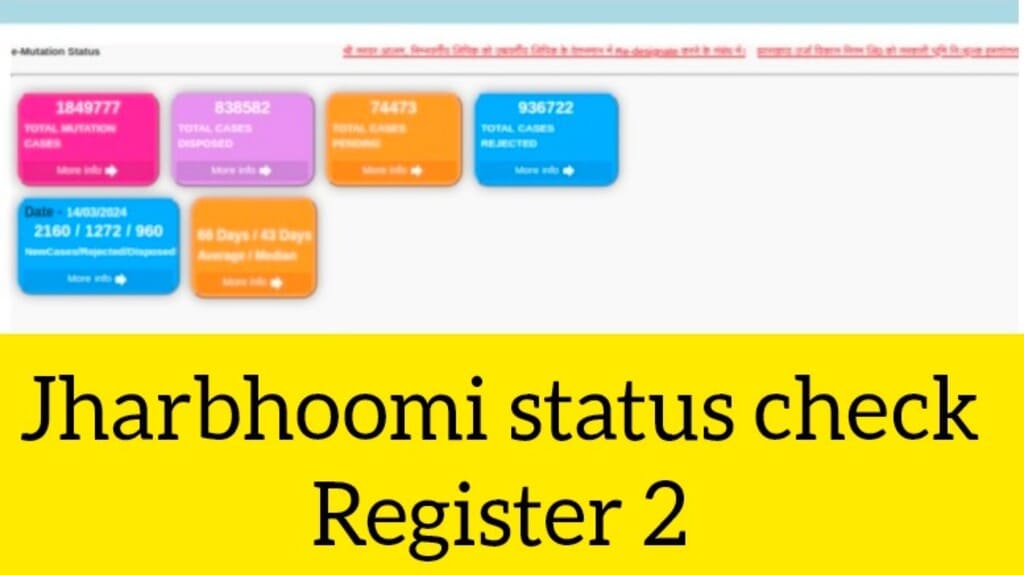
| Feature | Description |
|---|---|
| Name | Jharkhand’s official online land records portal |
| Launched | 2016 |
| Managed by | Department of Revenue and Land Reforms, Jharkhand |
| Website | https://jharbhoomi.jharkhand.gov.in/ |
| Account Required | No |
| Land Record Access | |
| Khata Details (land account information) | View ownership details, area, etc. |
| Khasra Details (specific plot information) | Identify plot boundaries, ownership details |
| Jharbhoomi Naksha (digital land maps) | Visually verify plot location and boundaries |
| Land Transaction & Right Details | |
| Register II | Access records of land rights and past transactions |
| Encumbrance Certificate Status | Check for any legal claims on the land |
| View Registered Deeds | Access copies of land transaction documents |
| Land Value & Transaction Tools | |
| Collector Rates | View government-determined land value in different areas |
| Deed Templates | Download templates for drafting land agreements |
| Area Unit Converter | Convert land area measurements between units (e.g., hectare, acre) |
| Stamp Duty Calculator | Estimate stamp duty payable for land transactions |
| Benefits | |
| Convenience: Access land records anytime, anywhere with internet | |
| Transparency: Clear and accessible land ownership details | |
| Efficiency: Streamlined land record management saves time and resources | |
| Empowerment: Landowners can make informed decisions about their holdings | |
| Reduced Disputes: Easier access to land records helps prevent property disputes |
Contents
- 1 JharBhoomi
- 2 What is JharBhoomi?
- 3 Benefits of Using JharBhoomi
- 4 Jharbhoomi Services
- 5 How to register on JharBhoomi
- 6 JharBhoomi status check
- 7 how to find your Jharkhand land record
- 8 JharBhoomi Login
- 9 JharBhoomi Register-II
- 10 JharBhoomi mutation status check
- 11 JharBhoomi Helpline
- 12 What is JharBhoomi?
- 13 What can I do on JharBhoomi?
- 14 How do I access JharBhoomi?
- 15 Do I need to register to use JharBhoomi?
- 16 How can I contact JharBhoomi for help?
Benefits of Using JharBhoomi
JharBhoomi offers a multitude of advantages for both landholders and the government:
• Convenience : Citizens can access their land records anytime, anywhere with an internet connection, eliminating the need for time-consuming trips to government offices.
• Transparency : The jharbhoomi portal promotes transparency by providing clear and easily accessible land ownership details.
• Efficiency : JharBhoomi streamlines land record management, saving time and resources for both citizens and government officials.
• Empowerment : Landowners are empowered to make informed decisions about their land holdings with readily available information.
• Reduced Disputes : Easy access to land records can help prevent property disputes arising from unclear ownership or boundaries.
Jharbhoomi Services
| Service | Description |
|---|---|
| Land Record Search | View details of your landholdings including owner names, plot size, land type, and ownership history. |
| Mutation Application | Apply online for changes in land ownership records due to sale, inheritance, etc. |
| Land Record Download | Download copies of your land records (may require fees). |
| Land Tax Payment | Pay your land taxes online for convenience. |
| Khatian Registration | Register your land rights (khatian) with the government. |
| Domicile Status Verification | Obtain official verification of your residency status in Jharkhand. |
How to register on JharBhoomi
JharBhoomi actually doesn’t require registration to access your land records.You can view your Khatian details directly without creating an account.Here’s how to do it:
1.Visit the official JharBhoomi website: https://jharbhoomi.jharkhand.gov.in/
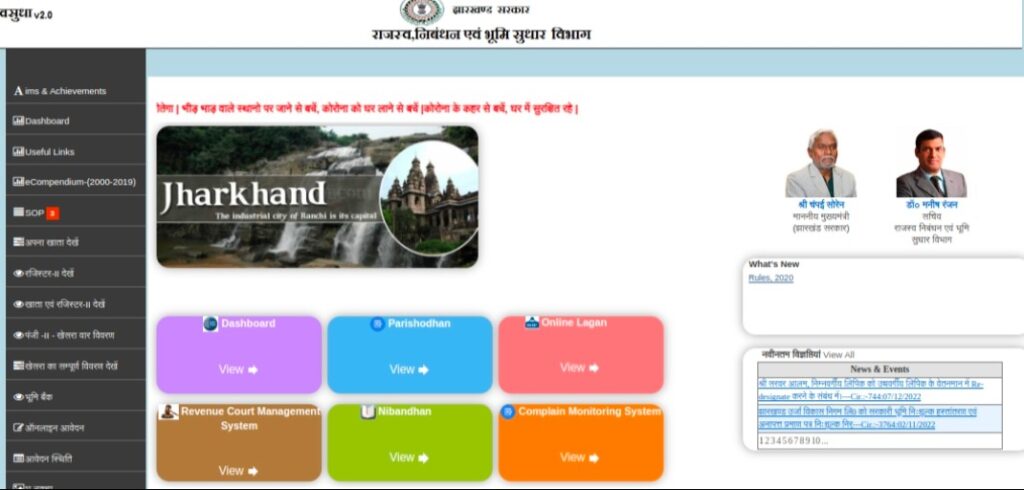
2.On the homepage, locate the section titled “See Account & Register-II” on the left-hand side menu.
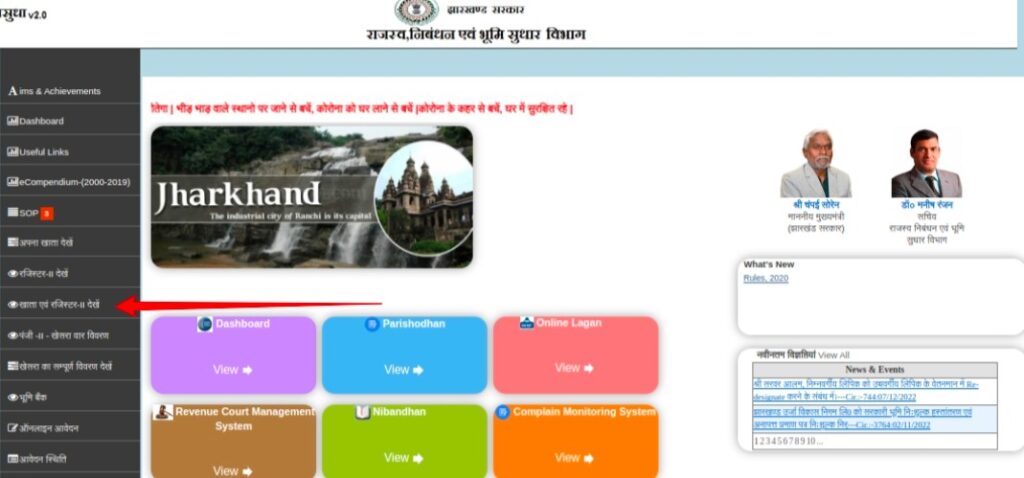
3.Click on “Khatian” within that section.
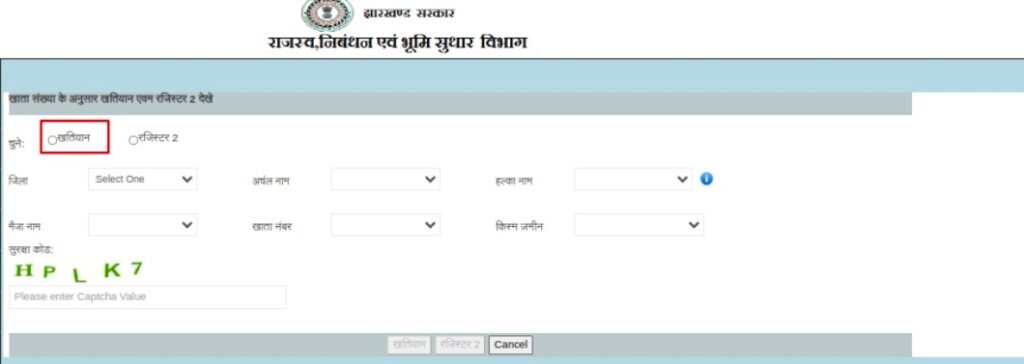
4.You’ll be presented with a form where you need to enter details to access your specific Khatian information.These details typically include:
• District Name
• Anchal Name (Area Name)
• Land Type
• Account Number

5.Once you’ve filled in these details, click the “Khatian” button.
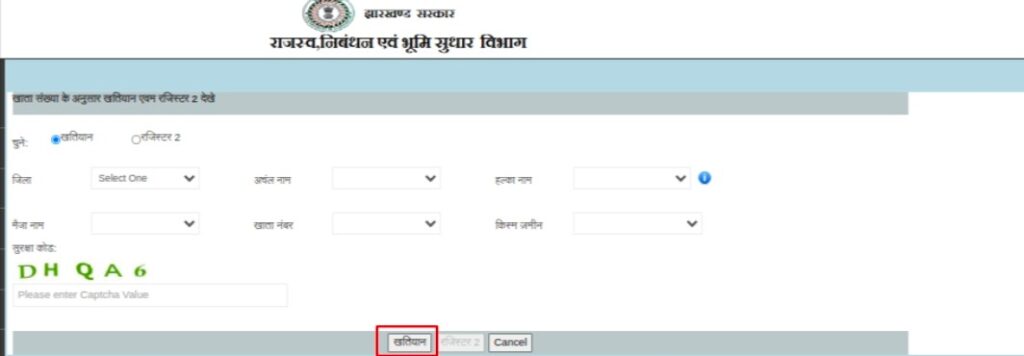
6.If the information you provided matches the records, your Khatian details will be displayed on the screen.You can then view or download them (depending on the website’s functionalities).
Remember
You’ll need to have your Khata number or relevant details beforehand to access this information.
JharBhoomi status check
Steps to check the application status on JharBhoomi :
1.Visit the Jharbhoomi portal https://jharbhoomi.jharkhand.gov.in/
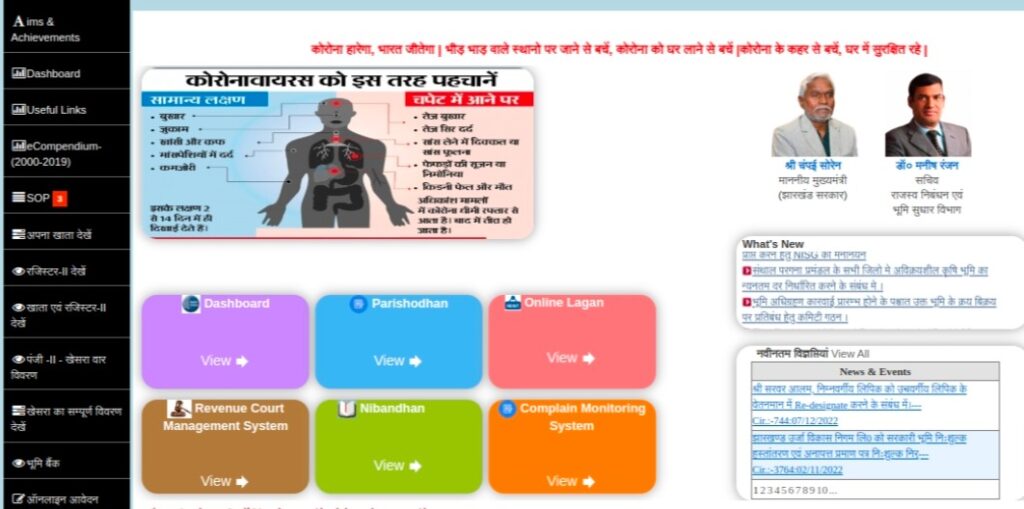
2.Look for the “Check Application Status” or “Aavedan Sthiti” option on the left side of the website.

3.This will likely take you to a Jharkhand district map.
4.Select your district and then the block where your land is located.

5.Once you select the block, a form will appear.You can choose to search by:
• Case Number
• Applicant Name
• Mauja (land location)
4.Fill in your chosen search criteria and the captcha code.

5.Click “Search” and the screen should display your application status.
how to find your Jharkhand land record
Here are the steps to find your Jharkhand land record online using the JharBhoomi portal :
No Registration Needed
1.Visit the JharBhoomi website: https://jharbhoomi.jharkhand.gov.in/
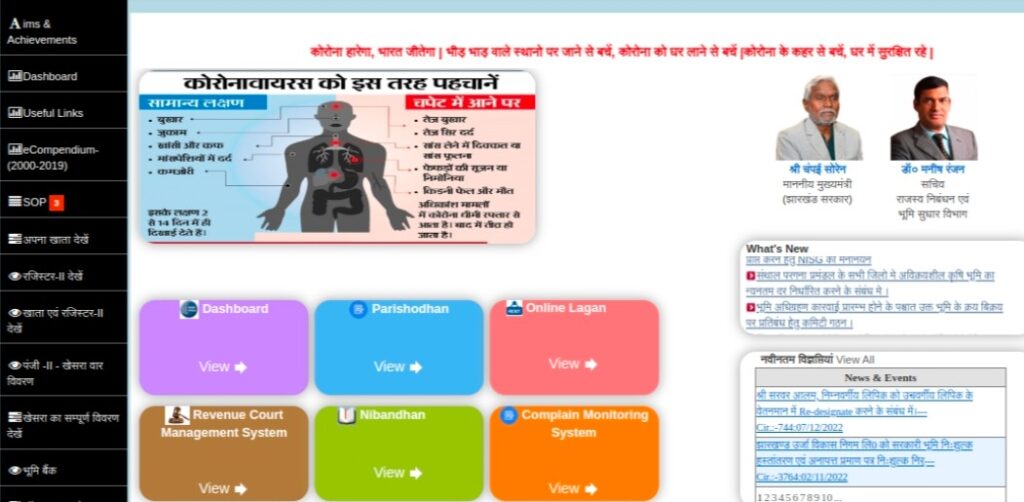
2.Choose your preferred language (Hindi or English).
3.You have two main options for searching land records:
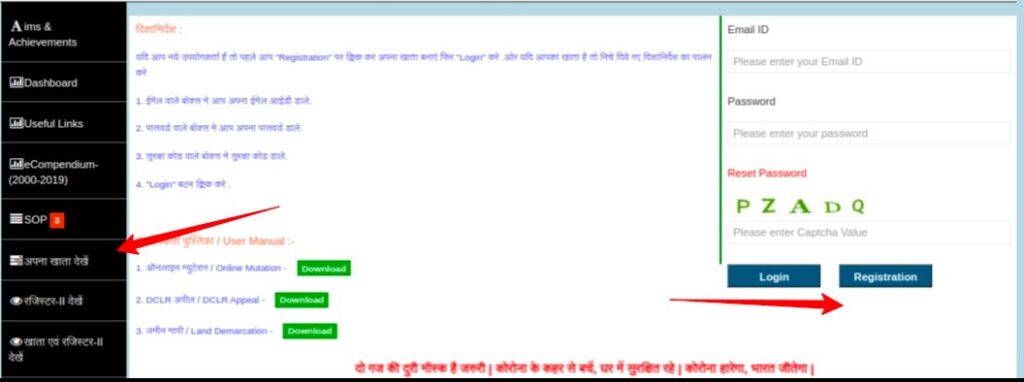
• Khata Details : If you know your Khata number (land account number), this is the quickest method.
Locate the section titled “See Account & Register-II” on the left-hand side menu.
Click on “Khatian” within that section.
Enter your district name, Anchal name (area name), land type, and account number in the designated fields.
Click the “Khatian” button to view your Khata details.
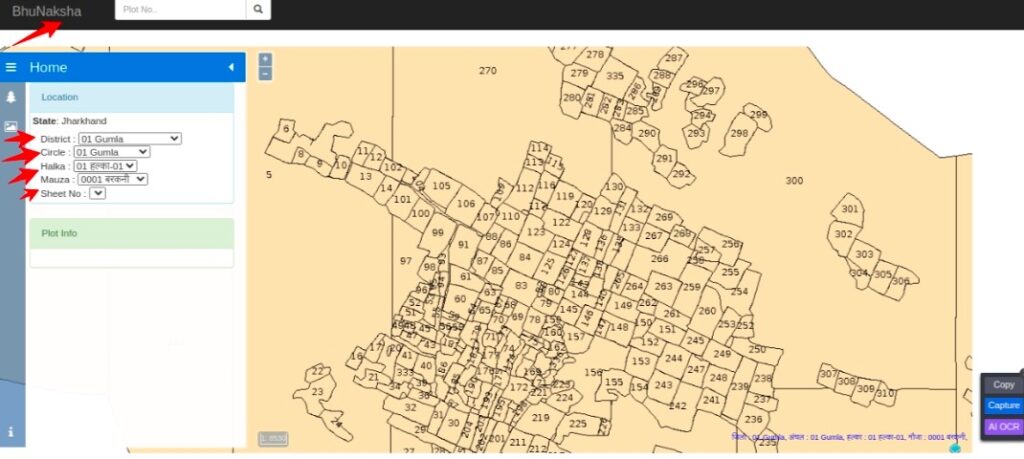
• Khasra Details : If you have the Khasra number (unique plot identifier) but not the Khata number, you can use this method.
Click on the “Khasra Details” option on the homepage or under the relevant section.
Now Enter the Khasra number in the designated field.
Click the “Submit” or “Search” button to view your Khasra details.
4.The portal will display your land record details if the information you provided matches their database.
JharBhoomi Login
The JharBhoomi portal seems to have two functionalities: checking land records and submitting online applications.
There might be separate login processes for each, but based on available information, here’s what we can gather about logging in for land record viewing :
1.Visit the official JharBhoomi portal https://jharbhoomi.jharkhand.gov.in/
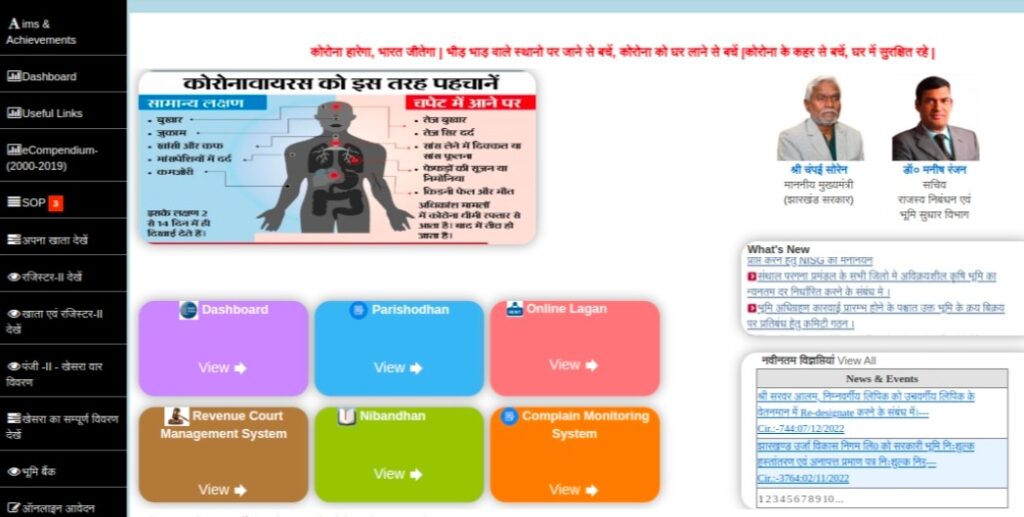
2.Look for the “Login” section or button.It might be on the left-hand side of the homepage.

There seem to be two options under the “Login” section :
• ” अपना खाता देखें” (Apna Khata Dekhen) – This translates to “View Your Account.” This option likely requires a registered account with login credentials.
• “खेसरा का सम्पूर्ण विवरण देखें” (Khesra Ka सम्पूर्ण विवरण देखें) – This translates to “View Complete Khatian Details.” This option might allow viewing land records without logging in, by using your Khatian number and registration number (Register-II)
If you haven’t registered for an account yet and only want to view land records :
1.Click on “खेसरा का सम्पूर्ण विवरण देखें” (Khesra Ka सम्पूर्ण विवरण देखें)
2.Enter your Khatian number and Registration-II number (found on your land documents)
3.Fill in the captcha code.
4.Click “Search” to view your land record details.
If you want to access features that require an account (like checking application status) :
1.Look for the “Registration” option under the “Login” section (it might be called “Register-II”).
2.Follow the registration process to create an account.You’ll likely need details like your name, address, and contact information.

3.Once registered, return to the “Login” section and use your registered email ID and password to log in.
Read Also
nadakacheri online portal karnataka
JharBhoomi Register-II
Register-II, also known as “Paji 2” in Hindi, is a document on the JharBhoomi Portal that contains details about land rights and ownership in the state of Jharkhand, India.It’s similar to land records found in other parts of the country.
• It’s one of the resources available on the JharBhoomi portal to view land records online.
• You don’t need to register on the JharBhoomi portal to access Register-II.
• To view Register-II details, you’ll need information like your district, block, and plot number (Khasra number).
JharBhoomi mutation status check
Steps to check your JharBhoomi mutation status :
1.Visit the official Jharbhoomi Jharkhand website (https://jharbhoomi.jharkhand.gov.in/)
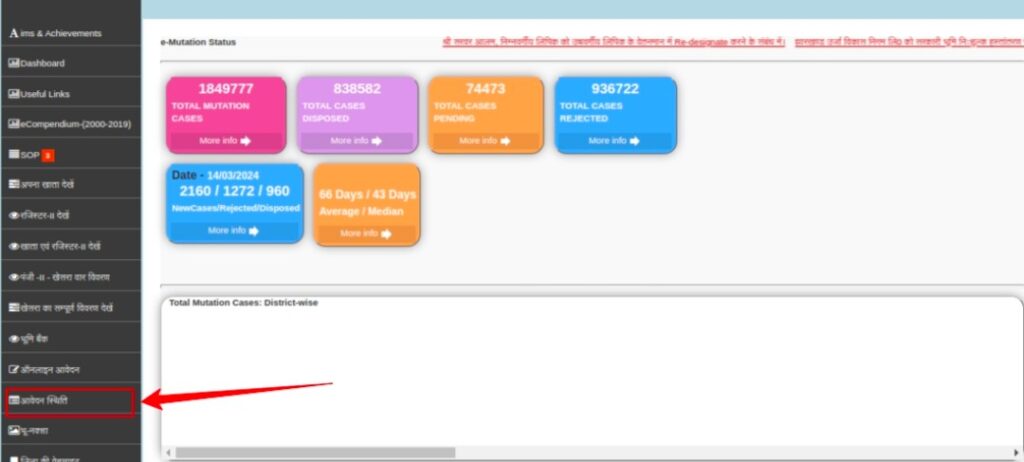
2.Look for the section labeled “Application Status” or “Aavedan Sthiti” (Hindi) on the left side of the homepage.
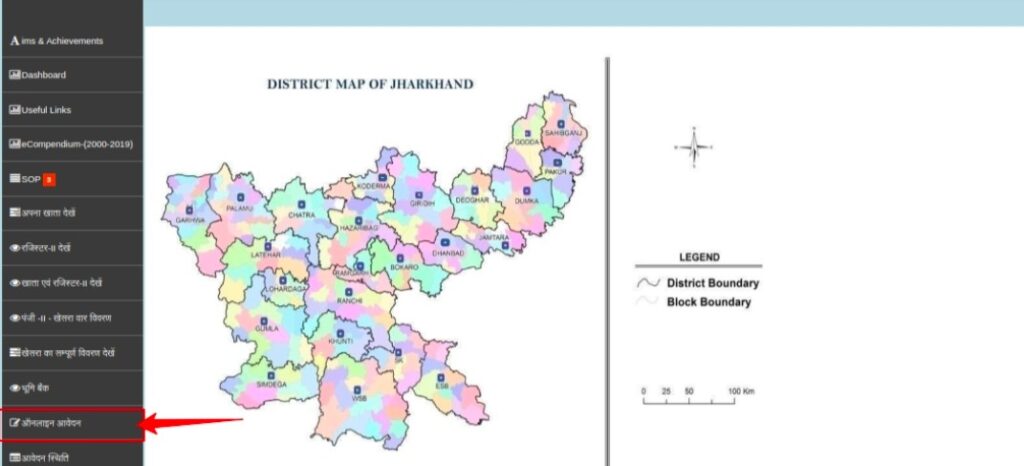
3.This might take you to a Jharkhand district map.Select the block where your land is situated.

4.Clicking on the “Block” button will likely display a form.Fill out the details as prompted.There are usually three options for searching the mutation status :
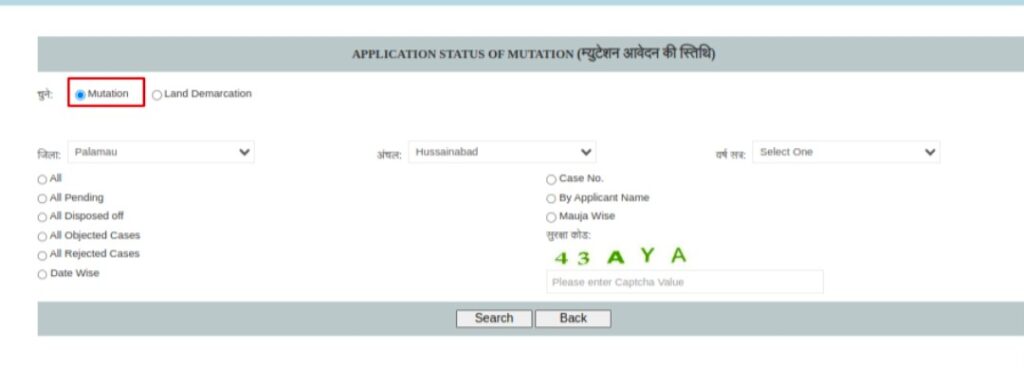
• Case Number : If you have the case number assigned to your mutation application, enter it here.
• Applicant Name : Enter your name as registered in the application.
• Mauja : This refers to the village where the land is located.Provide the Mauja name if known.
5.Once you’ve entered the chosen search criteria, click the search button.The system will display the current status of your Jharbhoomi mutation application.
JharBhoomi Helpline
Contact Number : +91 0651-2446066 Email: dolrjh@gmail.com
FAQ’s
What is JharBhoomi?
JharBhoomi is a web portal launched by the Jharkhand government’s Department of Revenue and Land Reforms. It allows citizens to access and manage their land records electronically.
What can I do on JharBhoomi?
JharBhoomi offers a variety of services, including:
Viewing land records online
Downloading copies of land documents (might require fees)
Checking land mutation status (changes in ownership)
Applying for various land-related services (might require registration)
How do I access JharBhoomi?
You can access JharBhoomi through their official website: https://jharbhoomi.jharkhand.gov.in/
Do I need to register to use JharBhoomi?
No, you don’t necessarily need to register to use some features of JharBhoomi, such as viewing public land records.However, if you want to access services like downloading documents or applying for land-related applications, registration might be required.
How can I contact JharBhoomi for help?
You can contact them with phone number or email address.
Use the “Contact Us” form on the JharBhoomi website.
Contact your local revenue office in Jharkhand for assistance with land records or any questions you have.
Jharbhoomi,Jharbhoomi login,Jharbhoomi status,jharbhoomi.nic.in mutation,Jharbhoomi Naksha,Jharbhoomi Register 2,Jharbhoomi Khatiyan